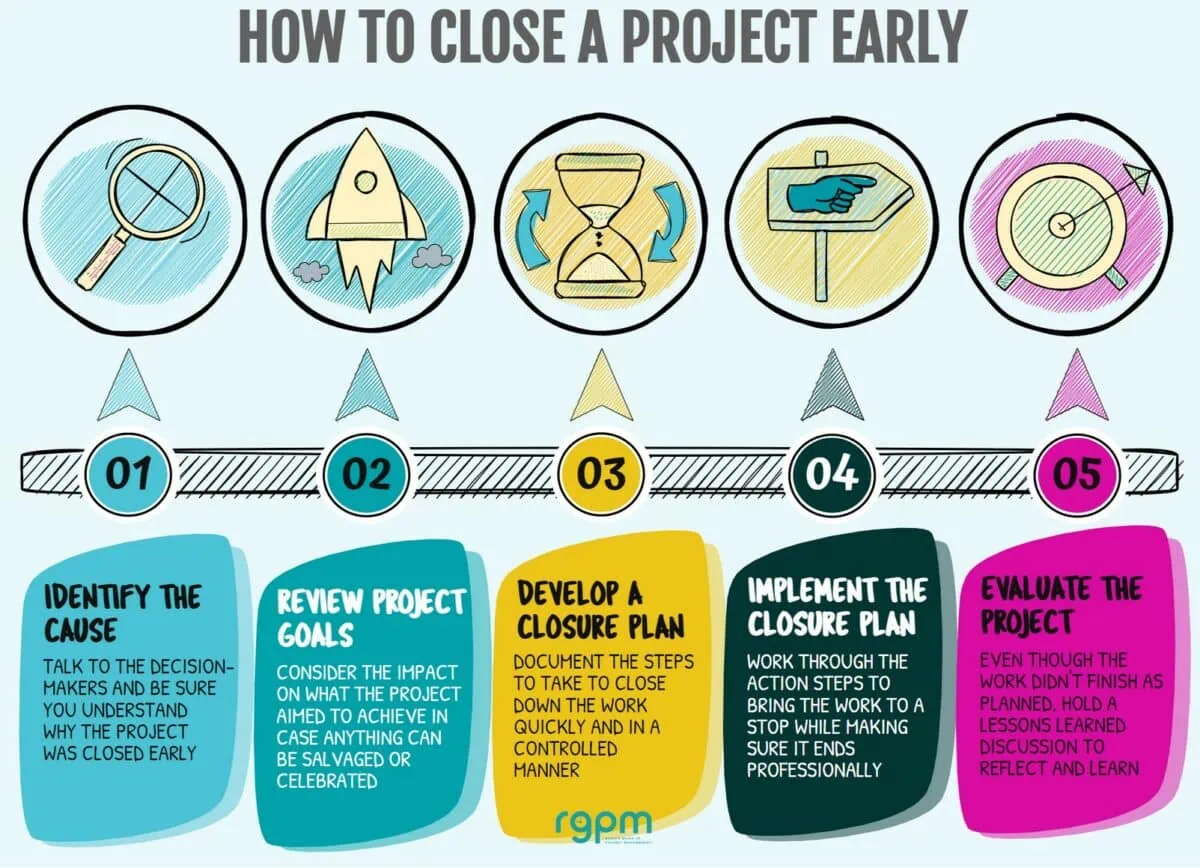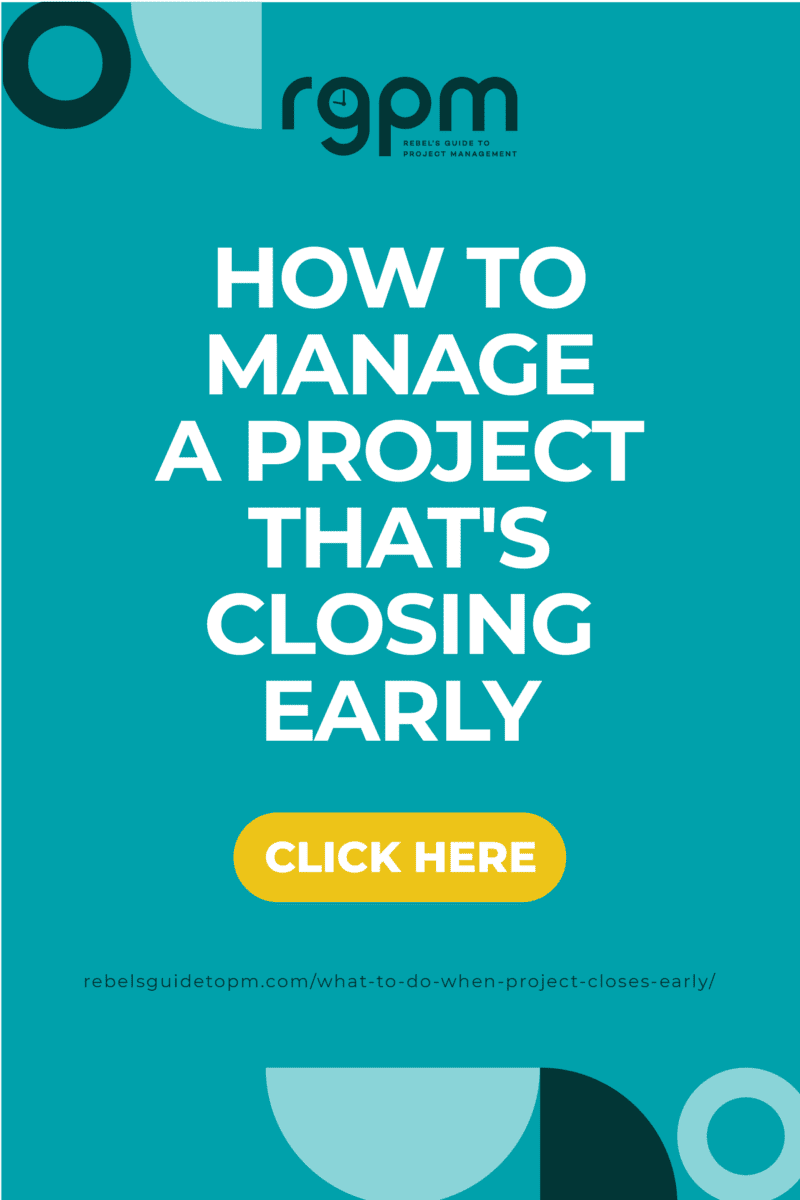What to do when your project closes early: A guide
Closing down a project early is very different to carrying out a controlled close when a project has reached its natural conclusion and delivered everything that stakeholders were expecting.
It’s more emotional, for one thing. You’ve invested time in this work, and now it’s being moved to the scrap heap.
When a project is unexpectedly closed early, it can be difficult to know what steps to take next. Should we just give up on it? Move on and forget it ever happened?
That’s not the right way to handle terminating a project early. With the right approach and strategy, you can assess the situation, develop an action plan and implement it effectively so that your team learns from this experience for future projects.
Even if there was nothing you could have done differently.
So whether your project is on its last legs, or you’re just planning ahead for the future, in this article you’ll learn what to do when a project is closed early.
Why do projects close early?
There are several reasons for early project termination:
- The project is no longer required, perhaps because the organizational strategy has changed
- The project can’t deliver what it set out to deliver for whatever reason, so the organization decides to cut its losses and stop the work.
Actually, that’s about it. It’s humans that stop the work, so the decision is taken by a senior leader, often not the project sponsor.
Someone decides that the project shouldn’t carry on. Sometimes that’s to do with internal politics; sometimes there’s a very good reason that is clear to everyone.
Other times, a project can be stopped because other work takes priority, but it’s not fully closed – just put on ice until there are resources and time available to pick it up again.
But let’s say you have been told your project will be shut down before its scheduled completion date, and not because you’ve completed all the work early. Here’s what to do.
- Identify the cause of closure
- Analyze the impact on project goals
- Develop a closeout plan
- Implement the closeout plan
- Evaluate what you did
- Thank the team (a lot, as long as it’s deserved!)

1. Identify the cause of closure
When a project is closed before the scheduled end, it is important to assess the situation in order to make sure everyone understands the cause of closure. Analyze the impact on project goals.
You might think this is obvious: the CEO has told you to stop work. But it is really important to be crystal clear about why work has stopped.
At the very least, you have to explain it to the project team, and probably to the users who were expecting whatever it was you were delivering.
Everyone needs to have the same message and hear the same story.
Was there an external factor that was out of your control? Did something go wrong with the execution or planning process? Were there any unforeseen circumstances that impacted progress?
It’s important to get as much information as possible so you can understand why the project had to be shut down early, and share that on with people who need to know.
2. Analyze the impact on project goals
Next, consider the project’s goals and what the impact of the stoppage will be on those. You might think: “Well, we can’t achieve them at all,” but it’s likely you’ve already completed something of value.
What can be tidied up quickly and delivered? What can be mothballed for a future project? What did you manage to complete already – perhaps you already hit a couple of the project’s goals?
These are the little successes you can walk away with, and celebrate with your team. Of course, there might not be any at all… but if there are pieces of the project that can be used, implemented, taught, shared and celebrated, then do it.
Tip
Find the little successes and celebrate those with your team.
3. Develop a closeout plan
As the project manager of a stopped project, you still have to bring the work (and the project team) to a controlled close. Your project lifecycle has come to an abrupt end, but fortunately you’ve probably already got an idea of what you would have done once the project reaches the end.
If you have a linear, predictive plan, or you have a PMO with a closure document template, then you can use that as the basis for your early close plan.
Work out your closeout plan: what you need to do to finish the job, albeit it was before you were all expecting to have to do so.
The activities you have to do are very similar to a planned project close:
- Write a closure document that explains why the project was closed, including formal sign off and approval for the closure (because you don’t want anyone asking you why the work was stopped in a couple of months)
- Archive and file any project documentation
- Create a financial report summarizing the state of play with the project budget
- Schedule a lessons learned meeting or retrospective
- Release the team back to the resource pool or their day jobs
- Close out any contracts – there might be penalties for not completing the work, so talk that through with the Legal team.
In addition, you’ll want to package up any deliverables that can be used, or would be useful for other projects, and hand those over as well.
Document the tasks you have to do and make sure the team stays around long enough to help you do them.
4. Implement the closeout plan
Unsurprisingly, next you have to follow through on that plan.
Hopefully, your action steps can be completed in a matter of weeks, if not days. When a project gets stopped, it’s usually for reasons like running out of money or a change of strategy or executive leader, and no one wants a project hanging around after the decision has been made to terminate it.
Work quickly through your action plan, highlighting any potential risks that might arise as a result of this closing phase, and hand them over to the managers who can deal with them.

5. Evaluate what you did manage to do and learn from the experience
Put that lessons learned meeting in the diary for as soon as possible, but not so soon that everyone will use the time to gripe.
I would organize two sessions – an informal one where everyone can express their shock, share their disappointment (or joy, I suppose it depends on what the project was), and whinge about the internal politics.
Then, when everyone has destressed from the experience, hold a more formal lessons learned. When everyone has a bit of distance from the shock, they’ll be able to share their feedback more constructively.
Ask questions such as “What do you think went wrong here?” and “How could we have prevented this outcome?” Listening carefully and taking notes during these conversations will help inform your next projects.
Let’s face it, if the project was cancelled by someone very senior, nothing you did or could have done would have made any difference to the outcome. But there might be some lessons in there that are still useful for future projects.
Assessing the situation is essential to understand why the project closed early and to determine how it affected stakeholders. This allows for reflection on what went well and what could have been improved upon, as well as identifying opportunities for growth and development.
Some of your project was completed, and it’s worth reflecting on and learning the lessons of that experience, even if you didn’t make it to the end.
Finally, it is important to share the lessons learned with team members who were involved in the project and stakeholders who may have had an interest in its outcome. This will help ensure everyone understands why certain decisions were made and provide an opportunity for collaboration moving forward so similar mistakes are not repeated.
Thank the team
You’ve wrapped up the project, held the lessons learned meeting and all the info is archived away.
Don’t forget to thank everyone involved in the project for their hard work and dedication. Doing so will help create an atmosphere of appreciation and respect which can be beneficial for future projects. Especially as they’re probably all feeling rather fragile about what a failed project is going to look like on their project management resume.
Common questions
Here are some more queries I often get asked when I’m mentoring project managers about closing down a project prematurely.
What project management team role can trigger a premature close?
The project director or project sponsor can trigger a premature close by instructing the team to wrap up the work. But the suggestion that the work is closed down can come from anyone. As a responsible project manager or project team member, you can recommend that a project is shut down if that is the best course of action for the business.
Before you go
Hopefully, the experience of closing a project prematurely is something that won’t happen to you very often.
It’s more likely that your projects will follow through to their natural conclusion, however hard that might be.
In that case, you need to read my next guide: how to close a project effectively. That’s all about how to carry out the project closure phase in a low-stress way, so go and read that one next!
Pin for later reading

